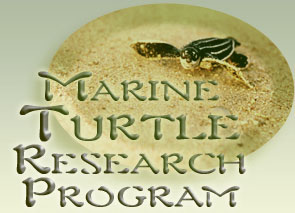
Pacific leatherback turtles migrate 6,000 miles across the ocean from their nesting sites in Indonesia to eat California jellyfish.
The Marine Turtle Research Program was established at the La Jolla Lab of the Southwest Marine Fisheries Service to address the priority actions identified in the U.S. Pacific Sea Turtle Recovery Plans. These actions include monitoring and protection of nesting populations, identify stocks, assessing population, and eliminating the take of nesting females and eggs.
 The Sea Turtle Research Group at NOAA is now actively seeking your help to report sightings of sea turtles to help document turtle presence along the Pacific coast. In particular, the data of interest includes the date observed, lat/long or approximate location, number of turtles, approximate size, species or description of coloring, behavior of the animal (e.g. basking, swimming, foraging), body condition (clean carapace, covered in algae). Photos are also helpful, if available.
The Sea Turtle Research Group at NOAA is now actively seeking your help to report sightings of sea turtles to help document turtle presence along the Pacific coast. In particular, the data of interest includes the date observed, lat/long or approximate location, number of turtles, approximate size, species or description of coloring, behavior of the animal (e.g. basking, swimming, foraging), body condition (clean carapace, covered in algae). Photos are also helpful, if available.
The Group also stresses that it’s important to not attempt to interact with or capture turtles (unless they are stranded).To report the sighting of sea turtles, please send the information via email to swfsc.turtle-sightings@noaa.gov.
There are 5 common types of sea turtles that may be found in California waters including Leatherbacks, Green Sea Turtles, the Pacific Hawksbill, Loggerhead, and Olive Ridley sea turtle. A comparison and identification guide can be seen here.
The Leatherback sea turtle, as one example, is a true ocean trekker. Using satellite tracking, scientists tracked one leatherback turtle that swam from Indonesia to the U.S. in a 12,000 mile foraging journey over a period of 647 days. Pacific leatherbacks migrate about 6,000 miles across the Pacific from their nesting sites in Indonesia to eat California jellyfish.
Leatherbacks follow their jellyfish prey throughout the day, resulting in turtles occupying deeper water in the daytime and shallower water at night (when the jellyfish rise up the water column). This hunting strategy often places turtles in very frigid waters. One individual was found actively hunting in waters that had a surface temperature of 32.72 degrees fahrenheit. Leatherback turtles are also known to pursue prey deeper than 1000 meters — well beyond the physiological limits of all other diving animals except for beaked whales and sperm whales.
Many sea tutles subsist almost entirely on jellyfish, making plastic in the ocean a key danger to their survival. Even small quantities of debris can kill sea turtles by obstructing their digestive tracts. These turtles have the highest risk of encountering and ingesting plastic bags offshore of San Francisco Bay, the Columbia River mouth, and Puget Sound.
